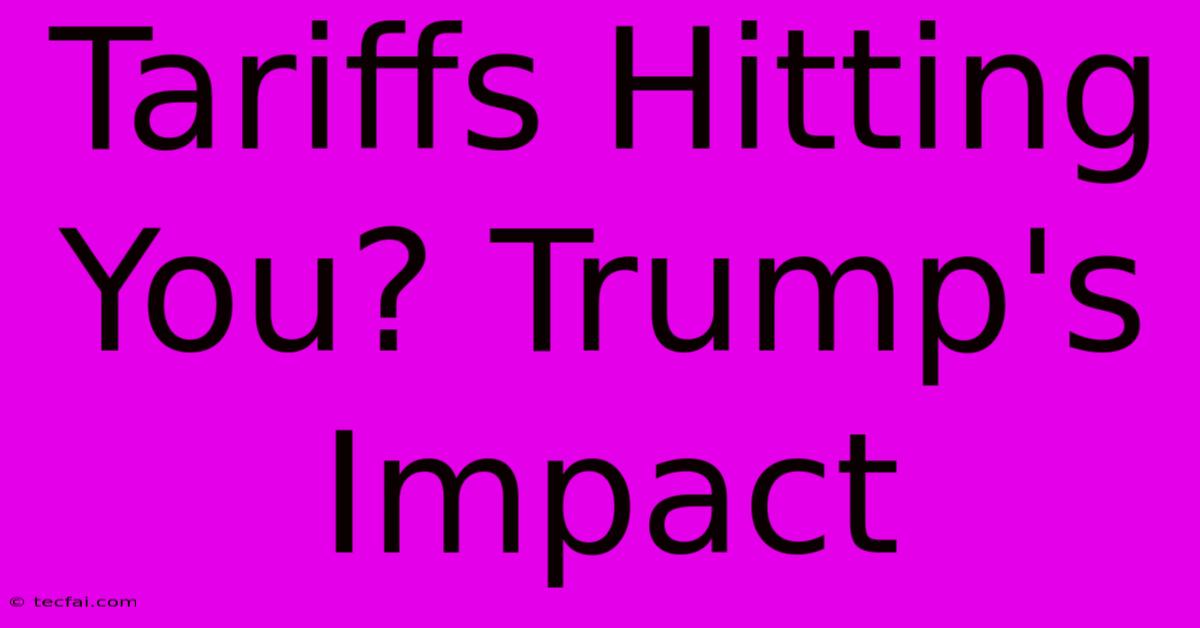Tariffs Hitting You? Trump's Impact

Discover more detailed and exciting information on our website. Click the link below to start your adventure: Visit Best Website tecfai.com. Don't miss out!
Table of Contents
Tariffs Hitting You? Trump's Impact on the American Economy
Donald Trump's presidency brought significant changes to US trade policy, most notably through the widespread implementation of tariffs. While proponents argued these measures would protect American industries and jobs, the impact was multifaceted and continues to be debated. This article explores the consequences of Trump's tariff policies, analyzing their effects on various sectors and the broader economy.
Understanding the Tariff Increases
Trump's administration initiated a series of tariff increases, primarily targeting goods from China, but also impacting other countries. These tariffs, essentially taxes on imported goods, aimed to level the playing field for American businesses and reduce the US trade deficit. Key targets included steel and aluminum, impacting industries reliant on these materials, and a wider range of consumer goods sourced from China.
The Rationale Behind the Tariffs
The stated goals of these tariffs were threefold:
- Protecting American Industries: The argument was that unfairly low prices from foreign competitors, often attributed to government subsidies, were harming domestic industries. Tariffs were intended to make imported goods more expensive, boosting demand for domestically produced alternatives.
- Reducing the Trade Deficit: A large and persistent trade deficit was seen as a sign of economic weakness. Tariffs were intended to discourage imports and encourage more balanced trade.
- Reciprocity and Negotiation: The administration used tariffs as leverage in trade negotiations, hoping to secure better deals with other countries.
The Economic Impacts: Winners and Losers
The economic effects of Trump's tariffs were far from uniform. Some sectors experienced benefits, while others suffered significant losses.
Winners (Limited and Often Indirect):
- Certain Domestic Industries: Some US industries, particularly those producing steel and aluminum, initially saw a boost in demand as imported goods became more expensive. However, the long-term benefits remain questionable, as discussed below.
- Government Revenue: The tariffs generated increased revenue for the US government, though this was often offset by other economic factors.
Losers: A Wider Impact
- Consumers: Higher prices for imported goods directly impacted consumers, leading to increased costs for everyday items. This inflationary pressure affected households across the income spectrum.
- Businesses: Many businesses, particularly small and medium-sized enterprises (SMEs) relying on imported goods for production or consumption, faced increased costs, reduced profitability, and supply chain disruptions.
- Global Trade: The tariffs disrupted global supply chains, impacting businesses worldwide and adding uncertainty to international trade relations. Retaliatory tariffs imposed by other countries further exacerbated the negative consequences.
Long-Term Consequences and Ongoing Debates
The long-term effects of Trump's tariffs are still unfolding. While some argue that certain industries benefited in the short term, others point to a net negative impact on the US economy. The increased costs for consumers, disruptions to global trade, and uncertainty created by the trade wars have raised significant concerns.
Evaluating the Success (or Failure)
Assessing the success or failure of Trump's tariff strategy requires a nuanced approach. While some domestic industries might have seen temporary gains, these often came at the expense of broader economic growth and consumer welfare. The increased trade tensions and retaliatory tariffs likely offset any benefits gained through increased domestic production.
Conclusion: A Complex Legacy
Trump's tariff policies represent a complex and controversial aspect of his economic agenda. While the intentions behind the tariffs were to bolster domestic industries and reduce the trade deficit, the actual consequences were more nuanced and widely debated. The long-term effects are still being analyzed, highlighting the intricate nature of international trade and the potential unintended consequences of protectionist measures. Understanding the full impact requires careful consideration of both the short-term gains for specific industries and the broader, negative consequences for consumers and the global economy.

Thank you for visiting our website wich cover about Tariffs Hitting You? Trump's Impact. We hope the information provided has been useful to you. Feel free to contact us if you have any questions or need further assistance. See you next time and dont miss to bookmark.
Featured Posts
-
Barcelona Vs Brest Champions League Match Thread
Nov 27, 2024
-
City 3 3 Feyenoord Espn Match Report
Nov 27, 2024
-
Man City Trio Back For Ucl
Nov 27, 2024
-
Watch Bayern Munich Vs Psg Champions League Live
Nov 27, 2024
-
Feyenoord Holds Man City 3 3
Nov 27, 2024
